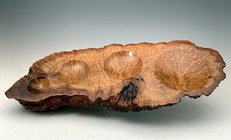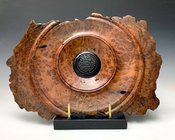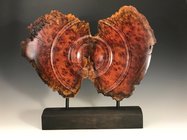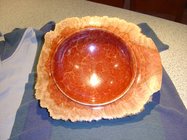Have any of you turned these burl caps of Australian Mallee, Red Gum or Coolebah which are showing up for sale on the interwebs? They look to have spectacular figuring and can be quite large.
-
It's time to cast your vote in the December 2025 Turning Challenge. (click here for details) -
Congratulations to Pat White for "Sicilian Mosaic" being selected as Turning of the Week for December 29, 2025 (click here for details) -
Welcome new registering member. Your username must be your real First and Last name (for example: John Doe). "Screen names" and "handles" are not allowed and your registration will be deleted if you don't use your real name. Also, do not use all caps nor all lower case.
You are using an out of date browser. It may not display this or other websites correctly.
You should upgrade or use an alternative browser.
You should upgrade or use an alternative browser.
Mallee burl cap
- Thread starter Richard Shelby
- Start date
I've seen a few of @Ricc Havens pieces in person, photos do not do justice.
On a smaller scale, i've turned pens & boxes from red mallee, brown mallee, red gum and blonde coolibah and at that size found all to behave nicely. Blonde coolibah doesn't like higher temperatures, so sharp & cool are the order of the day. Probably the same for the others, but i work slowly anyway so it's hard to say.
earl
On a smaller scale, i've turned pens & boxes from red mallee, brown mallee, red gum and blonde coolibah and at that size found all to behave nicely. Blonde coolibah doesn't like higher temperatures, so sharp & cool are the order of the day. Probably the same for the others, but i work slowly anyway so it's hard to say.
earl
It is truly a gift to have some of the species you have in Australia. And that bowl is stunning!
Hughie, can you explain what "Malee" is, and maybe what it might compare to for those of us in the clockwise swirly part of the globe.
Dean,Hughie, can you explain what "Malee" is, and maybe what it might compare to for those of us in the clockwise swirly part of the globe.
Mallee is fairly wide spread and I have to admit I had to look much of this up as I live in a major city on the coast and probably 6 hours drive from the nearest major supplier. There several smaller suppliers near me, the close they the dearer they seem to be.
The brown is what I see the most of. Theres a fair bit contention as to what colours can be once you move away from the red. I have had Mallee that looks white or beige, same grain structure, same bark, same hardness. But the pundits tell there is no white or beige. Brown most agree upon and of course Red speaks for its self. Its generally a burl and fairly hard although the root stock can be spectacular and sometimes not its the luck of the draw as far as I can see as I dont see much root stock. The root stock is perhaps the hardest and much depends on where you get it, live tree is one thing, long dead standing whole trees are another kettle of fish, dense and jarringly hard you work hard on these bowls always spectacular but its a real work out and not for the faint hearted. The comparison maybe your ironwood my hands on knowledge of your local tree species is a bit sketchy to say the least . The wood database has this to say about it Janka hardness 2,490 lbf (11,060 N) which is not the hardest Inland Rosewood would have to be up as one the hardest its abrasive and cut resistant.
https://www.wood-database.com/red-mallee/
Mallee country
Mallee, region of north western Victoria, Australia. It occupies about 16,000 square miles (41,000 square km) between the Wimmera and Murray rivers, and its climate is semiarid, with only 10–12 inches (250–300 mm) of rainfall annually.
Mallee trees
There are between 700 and 900 species of Eucalyptus endemic to Australia. Amazingly, over 50 per cent of them are known as mallees. Instead of just a single trunk, mallees have many stems that rise from a large bulbous woody structure called a lignotuber, or Mallee root. Most mallee's are slow growing, tough trees which originate from arid and semi arid regions. But they're found from Tasmania to the Tropics and so are iconic Australian trees well worth a closer look
The root which can include burl
Mallee root is a historic wood and charcoal, that is dwindling in supply in modern times. Instead of just a single trunk, mallee's have many stems that rise from a large bulbous woody structure called a lignotuber, or mallee root. Aboriginals prized it for it's semi sweet flavour for roasting and smoking Emu and Kangaroo suspended over their campfires. Good smoke flavour for Chooks [chicken] , Beef and Lamb.
Mallee and the wood turner, by far the most common is Brown Mallee from the Eucalyptus Dumosa is a species of Mallee, or rarely a small tree, very widespread across southern Australia from the goldfields of Western Australia east through South Australia to north-western Victoria and south-western New South Wales. Red Mallee or Eucalyptus oleosa. The brown would be the most common, the red on the other hand will will cost you more, I havent bought any burl for several years, often only at the annual woody show here in Sydney which due to covid etc has been closed for 2+ years, apparently its on again this month.
Thanks, Hughie. Maybe also analogous to our Mountain Mahogany, though I've never seen burls (burrs) from it or Ironwood.
Pretty much here all trees have burls, but Eucalypts seem to have then like covidThanks, Hughie. Maybe also analogous to our Mountain Mahogany, though I've never seen burls (burrs) from it or Ironwood.




